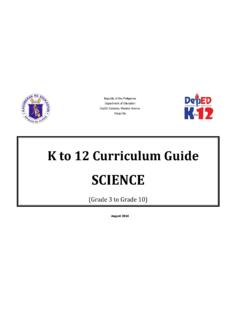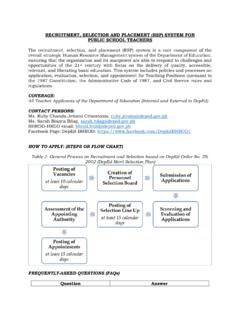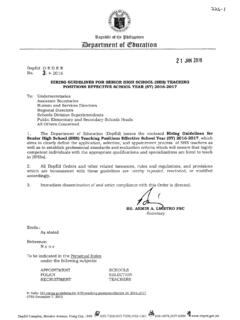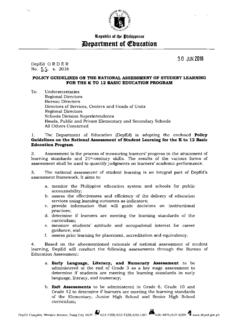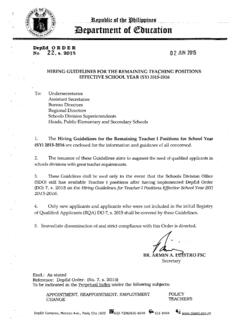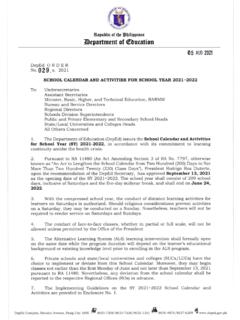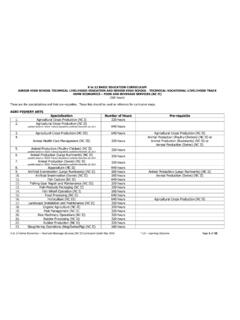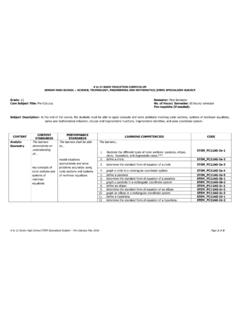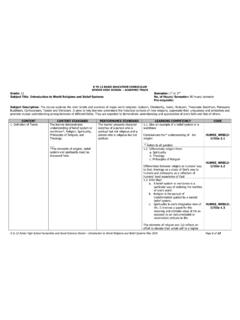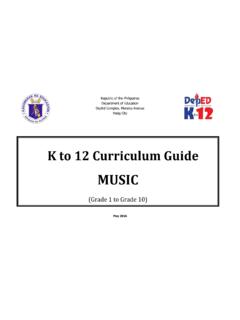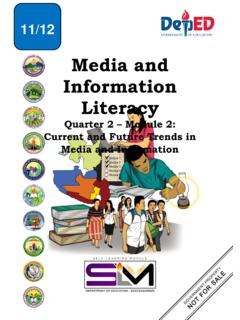Transcription of K to 12 Curriculum Guide - Department of Education
1 Republic of the Philippines Department of Education DepEd Complex, Meralco Avenue Pasig City May 2016 K to 12 Curriculum Guide ENGLISH ( grade 1 to grade 10) K to 12 BASIC Education Curriculum K to 12 English Curriculum Guide May 2016 Page 2 of 247 Learning Materials are uploaded at *These materials are in textbooks that have been delivered to schools. THE FRAMEWORK K to 12 BASIC Education Curriculum K to 12 English Curriculum Guide May 2016 Page 3 of 247 Learning Materials are uploaded at *These materials are in textbooks that have been delivered to schools.
2 I. PHILOSOPHY AND RATIONALE Language is the basis of all communication and the primary instrument of thought. Thinking, learning, and language are interrelated. Language is governed by rules and systems (language conventions) which are used to explore and communicate meaning. It defines culture which is essential in understanding oneself (personal identity), forming interpersonal relationships (socialization), extending experiences, reflecting on thought and action, and contributing to a better society. Language, therefore, is central to the peoples intellectual, social and emotional development and has an essential role in all key learning areas1.
3 Language is the foundation of all human relationships. All human relationships are established on the ability of people to communicate effectively with each other. Our thoughts, values and understandings are developed and expressed through language. This process allows students to understand better the world in which they live and contributes to the development of their personal perspectives of the global community. People use language to make sense of and bring order to their world. Therefore, proficiency in the language enables people to access, process and keep abreast of information, to engage with the wider and more diverse communities, and to learn about the role of language in their own lives, and in their own and other cultures.
4 II. GUIDING PRINCIPLES The K-12 Language Arts and Multiliteracies Curriculum is anchored on the following language acquisition, learning, teaching and assessing principles. All languages are interrelated and interdependent. Facility in the first language (L1) strengthens and supports the learning of other languages (L2). Acquisition of sets of skills and implicit metalinguistic knowledge in one language (common underlying proficiency or CUP) provides the base for the development of both the first language (L1) and the second language (L2)2. It follows that any expansion of CUP that takes place in one language will have a beneficial effect on the other language(s).
5 This principle serves to explain why it becomes easier and easier to learn additional languages. Language acquisition and learning is an active process that begins at birth and continues throughout life. It is continuous and recursive throughout students lives. Students enhance their language abilities by using what they know in new and more complex contexts and with increasing sophistication (spiral progression). They reflect on and use prior knowledge to extend and enhance their language and understanding. By learning and incorporating new language structures into their repertoire and using them in a variety of contexts, students develop language fluency and proficiency.
6 Positive learning experiences in language-rich environments enable students to leave school with a desire to continue to extend their knowledge, skills and interests. 1 1998. English Curriculum Framework. Australia 2 Cummins, J. 1991. The Acquisition of English as a Second Language in Spangenberg-Urbschat. K and Pritchard, R. (eds.) Reading Instruction for ESL Students Delaware: International Reading Association K to 12 BASIC Education Curriculum K to 12 English Curriculum Guide May 2016 Page 4 of 247 Learning Materials are uploaded at *These materials are in textbooks that have been delivered to schools.
7 Learning requires meaning3. We learn when we use what we know to understand what is new. Start with what the students know; use that to introduce new concepts. They use language to examine new experiences and knowledge in relation to their prior knowledge, experiences, and beliefs. They make connections, anticipate possibilities, reflect upon ideas, and determine courses of action. Learners learn about language and how to use it effectively through their engagement with and study of texts. The term text refers to any form of written (reading and writing), oral (listening and speaking) and visual communication involving language4.
8 The texts through which students learn about language are wide-ranging and varied, from brief conversations to lengthy and complex forms of writing. The study of specific texts is the means by which learners achieve the desired outcomes of language, rather than an end in itself. Learners learn to create texts of their own and to engage with texts produced by other people. Successful language learning involves viewing, listening, speaking, reading and writing activities5. Language learning should include a plethora of strategies and activities that helps students focus on both MEANING and ACCURACY.
9 Language learning involves recognizing, accepting, valuing and building on students existing language competence, including the use of non-standard forms of the language, and extending the range of language available to students. Through language learning, learners develop functional and critical literacy skills. They learn to control and understand the conventions of the target language that are valued and rewarded by society and to reflect on and critically analyze their own use of language and the language of others. An effective language arts and multiliteracies Curriculum satisfies the following principles6.
10 1. develops thinking and language through interactive learning; 2. develops communicative competence and critical literacy; 3. draws on literature in order to develop students understanding of their literary heritage; 4. draws on informational texts and multimedia in order to build academic vocabulary and strong content knowledge; 5. develops students oral language and literacy through appropriately challenging learning; 6. emphasizes writing arguments, explanatory/informative texts and narratives; 7. provides explicit skill instruction in reading and writing; 8. builds on the language, experiences, knowledge and interests that students bring to school; 9.
